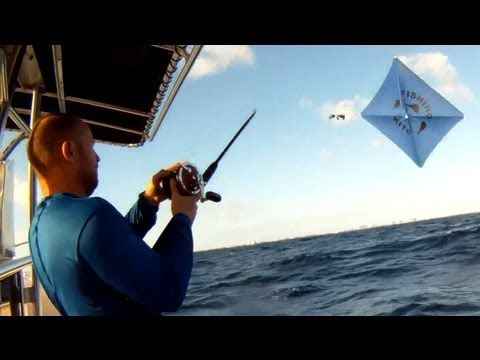February 11, 2021
Kite Fishing

Among other innovations to experience fishing unlike the usual way, one is to suspend one or more than one baits just below the water line through the use of a kite. Yes, that right, it’s a kite! This technique known as kite fishing originally surfaced in China, and was introduced to the West by Captain Bob Lewis from the United States. The target prey most kite fishers look up to include species like Sailfish, Tuna, Dolphin, Cobia, and Kingfish.
When the right equipment and a wisely selected day (keeping in mind a supportive weather with winds ranging from 10-15 knots) are coupled together, an ideal kite fishing adventure happens expectedly. The most convenient part of such fishing is that it allows anglers (either on shore or on a boat) to search for fish in areas which are otherwise inaccessible. In short, an angler on foot can explore locations reachable through a boat, and someone on a boat can send his bait to spots not safe to approach.
What to Expect When Kite Fishing
Kite fishing is something where the need defines the means. Fishermen from the Tobi Island build their own kites from large flattened leaves stiffened by rib-like structures from the coconut palm tree. Likewise, coconut fiber can be used to make a fishing line, and an artificial bait from spider webs. That’s what people have been doing from their available resources lately, and that’s perhaps the simplest of all constructions.
You can also get prepared gear from your local fishing store including a square kite (specifically designed for kite fishing), a reel (ideally electrically revolving), a fishing rod, release clips (attaching a bait line to the kite line), bait line supplies (including hooks, fishing corks, weights of lead, and fishing rings), and a fishing leader (connecting a line to hooks). For additional leverage, some anglers do attach a helium inflated balloon to a kite, however it’s still an added option. To assemble all the collected material, you’ll find an instructions’ manual with your gear. You may either follow that, or take an experienced kite fisherman to learn how things should work.
Fun fact: Florida’s southeastern coast has been considered as one of the prime locations to opt for kite fishing endeavors.
Kite Fishing Tips
- Do not use a regular fishing line for kite fishing as it has the tendency to recoil after it gets broken.
- Avoid arranging too long of a kite fishing line as it may make you lose control of your kite, or flying may not happen at all.
- A kite line under tension can possibly become sharp enough to cause serious injuries to your hands and fingers and to others, So, always wear gloves and keep people out of your way i.e. preferably make them stand behind you.
- Initially being a beginner, attach only one bait line to your kite, and think of deploying any further when you’ve mastered taking care of one.


